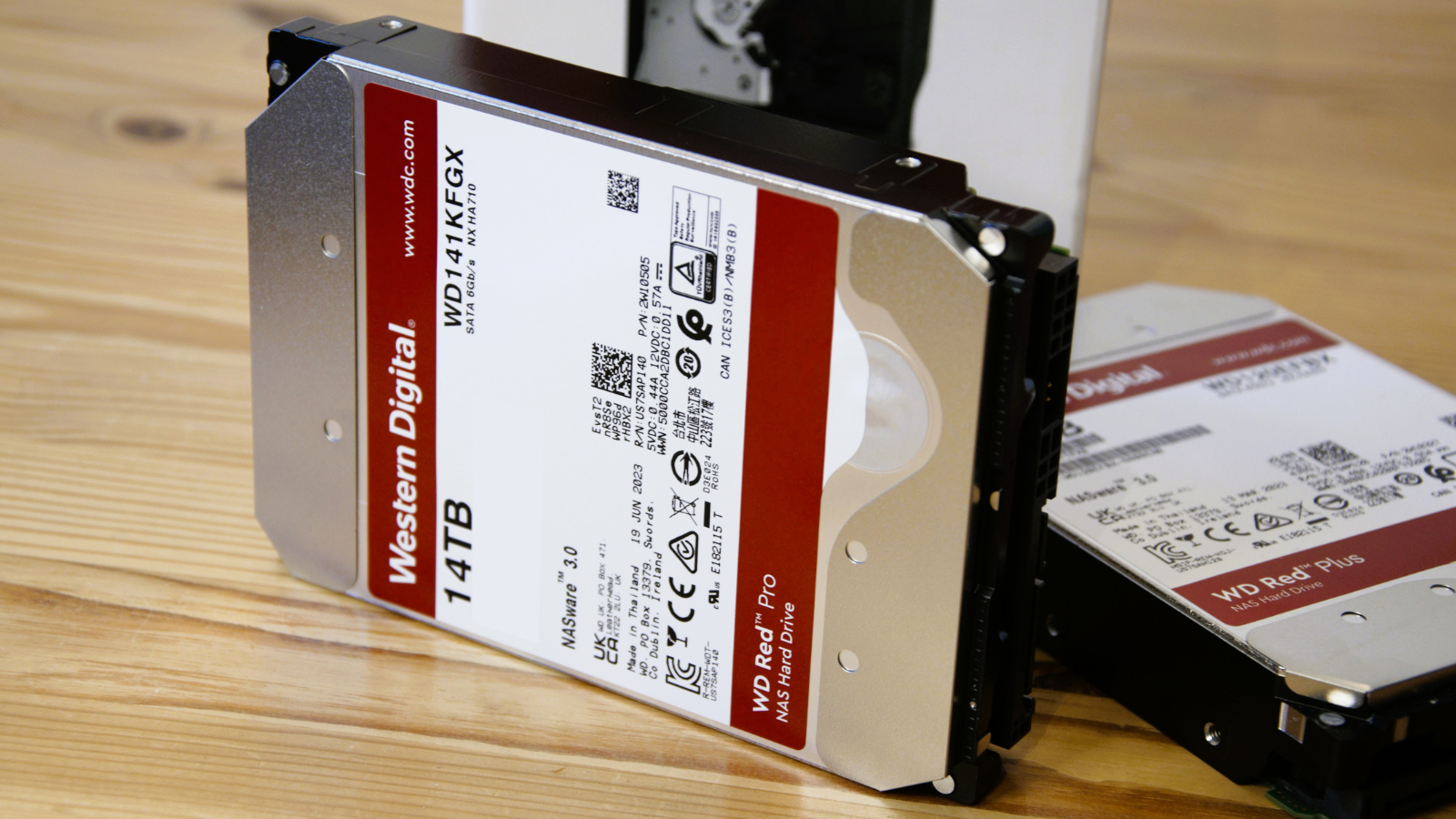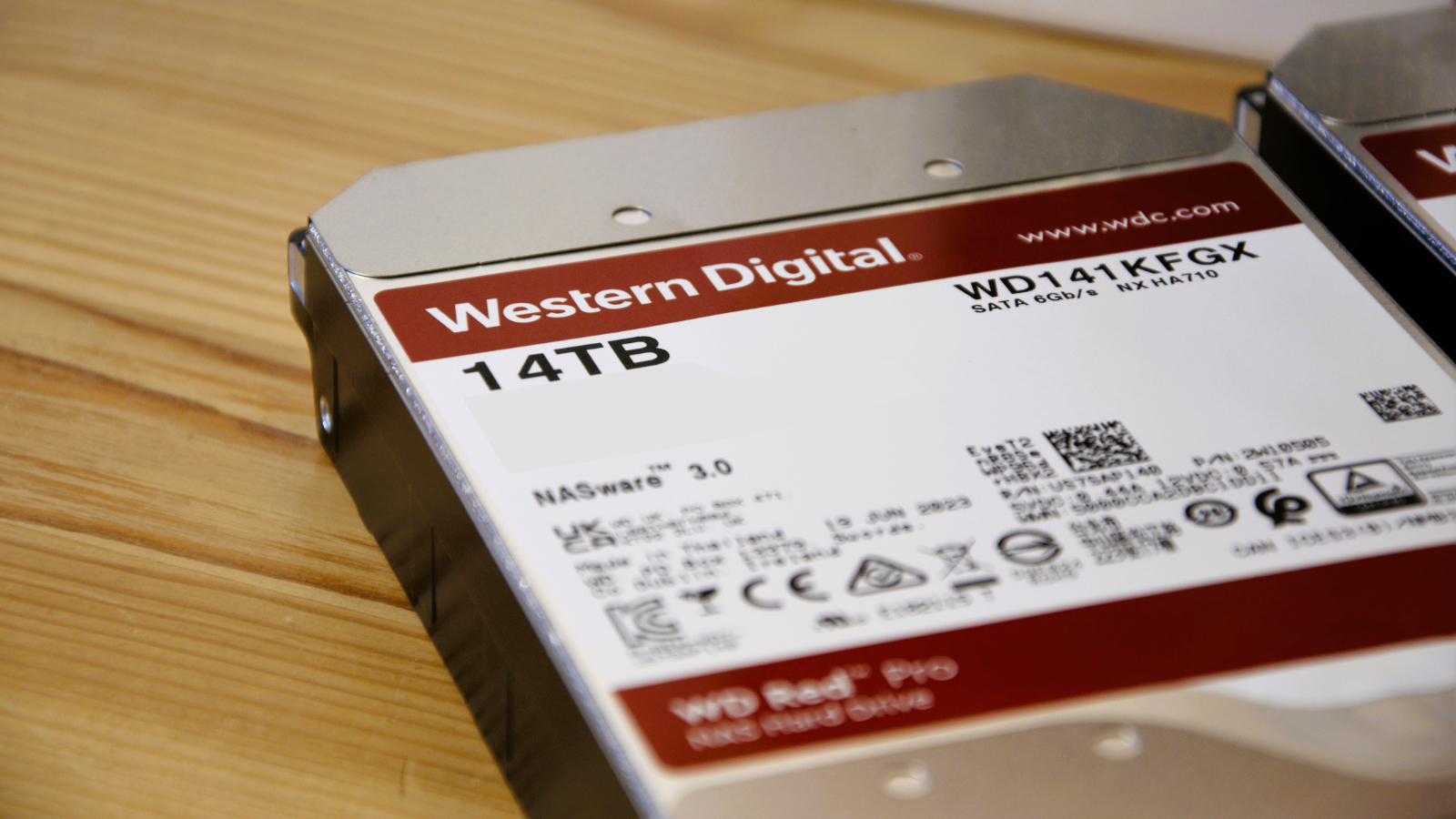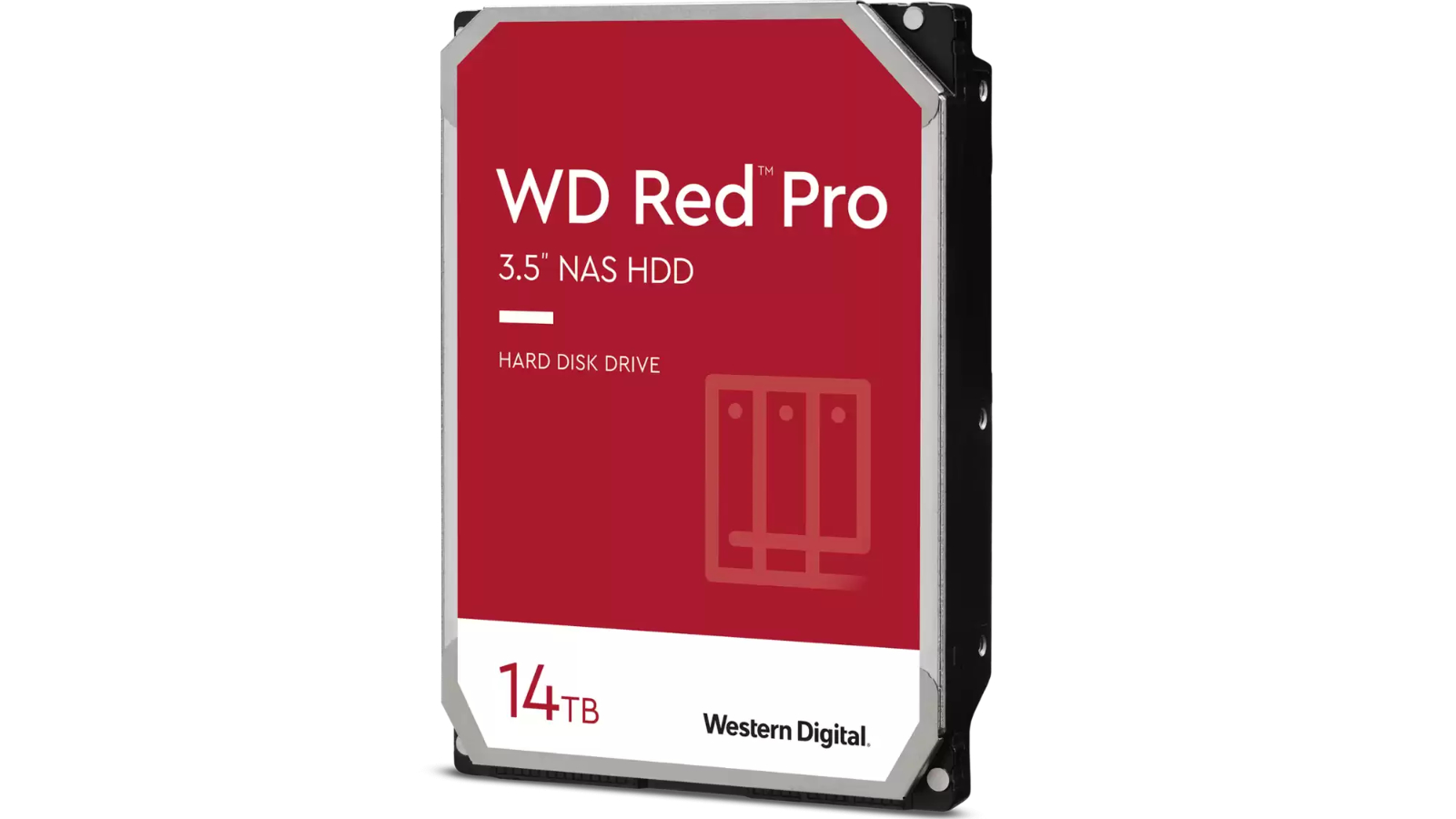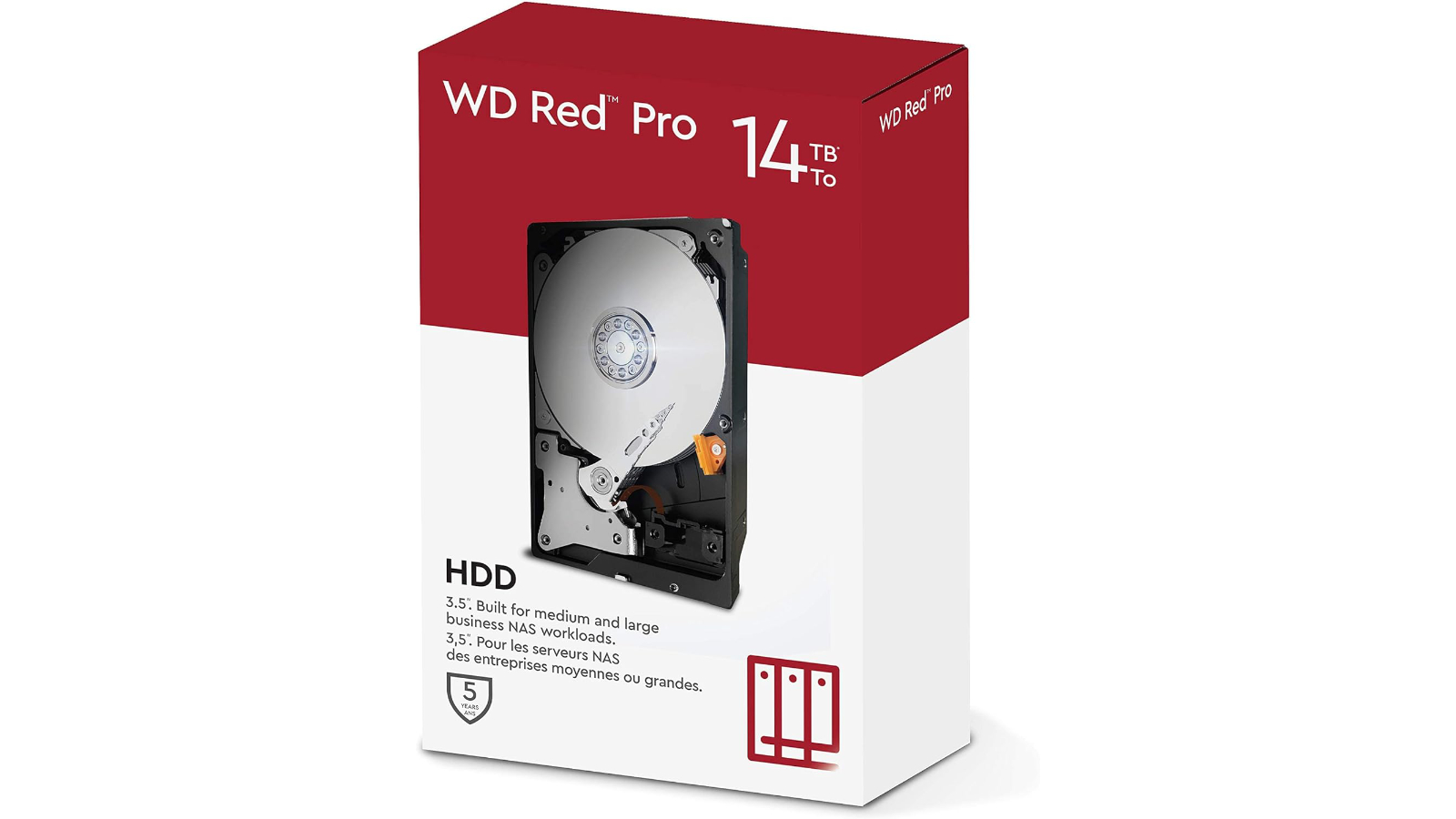TechRadar Verdict
The performance might have been slightly better, but it is difficult to argue with the resilience of this drive. Where European customers might baulk is at the price, and it isn’t cheap in the USA, either.
Pros
- +
Better than Red Plus Series
- +
5-year warranty
- +
550TB/y workload
Cons
- -
Not price competitive
Why you can trust TechRadar
One-minute review
In some respects, conventional hard drive technology has been the dead-man-walking of information technology for some time. Yet, solid-state drives still haven’t hit the capacity and price-per-terabyte advantages of spinning rust despite the drives getting bigger and cheaper.
The Red Pro series by Western Digital was one of the first NAS-supporting drives on the market, and the options have expanded to include 2, 4, 6, 8, 10, 12, 14, 16, 18, 20 and 22TB capacity drives.
Built for 24x7 multi-user NAS environments, all the drives are rated for 550TB/year workloads, have 2.5 million hours between failure, and come with a five-year warranty.
Today, we’re looking at the 14TB model, occupying a sweet spot between the cheaper but smaller capacity drives and the most enormous capacities.
The 14TB WD141KFGX is a 7200rpm 3.5-inch hard drive that is helium-filled for reduced resistance, and it comes with 512MB of cache and eight high-density platters. And, in our testing, it can read speeds close to 265MB/s and write 250MB/s, close to double the throughput of a 2.5GbE gigabit Ethernet port.
The quoted cost is $310 from Western Digital, but closer to $300 online. That’s only $23 more than the 12TB option, making this drive better value. However, it's more expensive than the similarly specified Seagate IronWolf Pro.
It all comes down to your experience with WD Pro drives and whether these will become a failure concern once in a live system. Western Digital believes they should be highly resilient, but all drive makers claim this high ground.
Sign up to the TechRadar Pro newsletter to get all the top news, opinion, features and guidance your business needs to succeed!

WD Red Pro 14TB: Pricing and availability
- How much does it cost? $310, £398.99
- When is it out? It is starting to be available now
- Where can you get it? Direct from Western Digital or through online retailers like Amazon.
The official US cost of the 14TB Red Pro is $310 direct from Western Digital is $310, but on Amazon.com, the same drive is $10 cheaper at $300.
Comparing it to the drives directly above and below it, the 12TB Red Pro costs $259.99, and that drive is therefore cheaper per TB, but with a smaller cache, it is also slightly slower.
The 16TB Red Pro offers better value at $320, just $10 more for 2TB more capacity, but it is marginally slower.
An interesting comparison can be made with the Seagate IronWolf Pro drives, where the IronWolf Pro 14TB is just $240 on Amazon.com. But what helps the Seagate argument is that the IronWolf Pro drives also come in two and four-drive packs, reducing the unit cost further.
For those buying outside the USA, the pricing is less competitive. The UK official price of the 14TB Red Pro is an eye-watering £398.99, based on the current exchange at the time of writing, which is the equivalent of $503.83. That’s 62.5% more expensive.
The markup for European customers for the Seagate IronWolf Pro isn’t as much, and the asking price is also lower.
With the drives having a close specification, it can come down to what deals are available on the drive capacity you want and how you feel about a specific drive brand.
- Value: 3 / 5

WD Red Pro 14TB: Specs
| Feature | Spec |
|---|---|
| Model No. | WD141KFGX |
| Capacity | 14TB |
| Quoted Transfer Speed | 255MB/s |
| Connection | SATA III 6Gb/s |
| Cache | 512MB |
| RPM | 7200 |
| Encryption | No |
| Dimensions | 147.3 x 101.6 x 25.4 mm (WxHxD) |
| Weight | 689g |
| Power Active/Idle/Standby | 6.2/3/0.8W |
| Yearly Workload | 550TB |
| MTBF | 2.5M hours |
| Warranty | 5-years |
WD Red Pro 14TB: Design
- Resilience over performance
- Helium filled
- Time Limited Error Recovery
From the outside, there isn’t anything exceptional to point out because, as you might expect, all the clever stuff is well out of sight.
Drives for NAS use aren’t designed to achieve the best transfer performance but for low power consumption and maximum endurance. Therefore, the engineers behind the Red Pro WD141KFGX 14TB created a 7,200 RPM drive utilising eight high-density platters and replaced the air inside the case with helium for reduced resistance. The gas reduces mechanical wear, the build-up of heat and the transmission of vibrations, lowers power consumption and enables platters to be more tightly packed.
This drive doesn’t offer any of the more sophisticated magnetic recording technologies on the 22TB models, such as shingled magnetic recording (SMR). However, conventional recording technology does deliver better performance overall.
The power consumption of the drive is low, considering the number of platters and the amount stored on each one, at around 6.2W under load, and less than half of that when not in direct use.
The electronics of the WD141KFGX are, as we should expect, made for resilience and reliability. It uses the well-considered Avago drive controller, and the motors are handled by a common Renesas part. Caching is provided by a Samsung-made DDR3 chip, but given the vagaries of the DRAM spot market, that might be something that changes over time.
The 512MB of cache is double that of the smaller Red Pro series, and having more cache is never a poor choice for overall performance.
For those who don’t live in Earthquake zones, the idea that server drives might need to be protected from shock might seem odd. But plenty of regions experience them and other issues that this design is resilient against.
The critical shock resistance component is 3D Active Balance Plus, which we’ve seen previously on Enterprise-class drives. What this technology aims to achieve is for drives in an array to avoid resonance synchronisation. This could cause excessive wear and noise if all the drives performed identical options at the same time. Alongside the pack management, the active balance technology tracks all shock events and makes tiny head height adjustments to ensure they never come in contact with the recording surface.
The quoted MTBF is 2.5M hours or 285 years, even if nobody will live long enough to complain if they don’t last this long. The best way to consider MTBF is to divide the time between the number of drives of this type. Therefore, if you have 100 of these drives, one will theoretically die every 2.85 years.
It's debatable if that is how drive reliance truly works, but it’s a way of adjusting expectations. In our experience, drives tend to cluster their failures with a sufficiently large enough pool you might see a group of drives die early on, with other drives going well beyond expectations.
The final brick in the Red Pro defensive wall is TLER or Time Limited Error Recovery, something that other makers have but have branded differently. If a drive hits a bad sector, software runs on the controller to recover the sector, or failing that, mark the sector as bad and map in an alternative spare sector. Most NAS environments will throw out any drive that failed to respond within 7 seconds, marking the whole device as ‘bad’. What TLER does is completely disable all background operations on the HDD. This focus makes the rereading and copying process safe for the hard disk drive and speeds up the process so that the NAS environment doesn’t disavow the drive.
While the advantages of this technology are well documented, it is worth stating that it is not ideal to run a mix of drives with and without this type of technology.
Another side note is that, according to Western Digital, "Annualized Workload Rate = TB transferred x (8760 / recorded power-on hours). The maximum rated workload is specified for operating at typical temperature of 40C. Workload Rate will vary depending on your hardware and software components and configurations."
Therefore, depending on your temperature and region, the workload levels might differ, which is unhelpful news for those looking to manage their drives.
- Design: 4 / 5
WD Red Pro 14TB: Performance
- Could be quicker
- Faster than the Red Plus
| WD Red Pro 14TB | WD Red Plus 12TB | ||
|---|---|---|---|
| Model | WD141KFGX | WD120EFBX | |
| CrystalDiskM. | Read MB/s | 263 | 217 |
| Write MB/s | 265 | 214 | |
| ATTO | Read MB/s | 250 | 208 |
| Write MB/s | 251 | 210 | |
| AS SSD | Read MB/s | 251 | 194 |
| Write MB/s | 251 | 195 | |
| AJA System Test | Read MB/s | 254 | 202 |
| Write MB/s | 254 | 201 |
Unfortunately, we didn’t have access to a Seagate IronWolf Pro 14TB to make a direct comparison. But we did have a WD Red Plus 12TB drive, and that might be another choice you might consider if you want Western Digital and a cheaper option.
Typically, benchmarks don’t align because the way they test is inherently different. But here, many of the synthetic tests deliver almost identical numbers.
While the 12TB Red Plus isn’t a perfect match for its slightly larger Pro counterpart, we can reasonably assert that the extra cache (512MB vs 256MB) provides about 20% more performance in both reading and writing.
However, what this might translate into for a NAS could be pretty small. Since the performance experienced by anyone connected to the device will be coloured by the number of drives in the array and the network interface they’re using.
Therefore, unless the NAS has better than 1GbE LAN ports when using a single drive, there will be no difference since the drive speed isn’t the limiting factor. If the LAN interface is 10GbE, then at least five drives of the Plus would be needed against four of the Pro to achieve roughly 1GB/s of throughput.
The Pro drive is advantageous if the array needs to be rebuilt or filled with USB-connected data, where it will be approximately 20% quicker to complete that exercise.
We should also mention that the Plus drive only comes with a three-year warranty and has a rating of 180TB per year, but curiously, the same million-hour MTBF.
Those thinking the Plus might be for them need to consider that the largest Plus drive is 14TB, whereas the Pro series goes up to 22 Terabytes.
What we can’t reasonably test is the endurance claims, as the five years needed to check this would make the review impractical.
- Performance: 4 / 5

Competitors
The competitors for the Red Pro are the Seagate IronWolf Pro, the Synology HAT5300 and the Toshiba N300.
Seagate IronWolf Pro drives are cheaper, offer a similar specification and are closer to 285MB/s transfer speeds, even if they only have 256MB of cache. The downside to the IronWolf Pro 14TB is that it consumes more power (7.9W vs 6.2W), has a lower 300TB workload, and has an MBTF of only 1.2 million hours (136 years).
But in most respects, it’s a good alternative.
The Synology HAT5300 is about the same speed as the Red Pro but has the same workload per annum (550TBW per year) and MTBF of 2.5M hours. But the cost is £507.31 ($438.06) for the 12TB model and £654.97 ($579.99)for the 16TB option, making them remarkably expensive per TB.
The cheapest option is undoubtedly the Toshiba N300, with the 12TB model (HDWG21CEZSTA) costing just $209.99 (£204.05) from an online retailer. Even the 16TB drive is under $300, and an 18TB model is available. It has the same cache size as the Red Pro and similar performance but only has a three-year warranty.
Verdict
To our minds, there are two issues with the WD Red Pro at the larger capacities, and the first of those is that we’ve seen plenty of NAS drives die ahead of the quoted endurance timescales. Maybe Western Digital has engineered a solution to this point, or we just got unlucky with our previous drives. But there isn’t any way we’d run an array without a hot-swap mechanism ready to take over, irrespective of the brand.
It's in the maker's best interest to avoid in-warranty failures, so we’re confident that drives made today are the best they can be, but is that good enough?
The second issue is the price, which doesn’t appear to take much account of what Seagate and Toshiba are doing and the reputation of those competitors drives.
Some premium pricing might be acceptable if Western Digital had a superior quality or service reputation. But there is a noticeable difference in cost between this drive and the Seagate IronWolf Pro, which has the same 5-year warranty and a 300TBW per year workload.
Unless you have a server that thrashes its drives or repeatedly resilience tests burn through the TBW, the IronWolf Pro might be resilient enough.
Depending on how many of these drives you buy, the cost of picking the WD Red Pro might represent a significant chunk of change. But those are choices for IT Managers to make and justify to the finance department.
The WD Red Pro series are fine drives performing reasonably well and are designed for NAS deployments. It only comes down to the cost and if you consider them worth the extra.
Should I buy the WD Red Pro 14TB
| Value | Increasing the yearly workload to 550TB WD has also hiked the price, but too much. And European pricing is dire. | 3 / 5 |
| Design | Lots of resilience tricks and low power consumption are the hallmarks of this design. | 4 / 5 |
| Performance | Considering its 7200 RPM and 512MB cache, we expected it to be faster | 4 / 5 |
| Overall | A resilient design that costs too much for what it offers | 4 / 5 |

Buy it if...
Resilience is key
With a TBW of 550TB per year, these are some of the more reliable NAS drives available, but you will pay for the privilege.
You already use WD Red Pro
Having mixed brands in a NAS can be a bad idea since the makers design them to work in harmony with their kin, not other brands. There are features in the Red Pro that only work with others from this series.
Don't buy it if...
You want ultimate performance
Seagate IronWolf Pro are faster, and any NAS SSD will be substantially quicker. If performance is the critical factor, then the WD Red Pro isn’t the right choice.
You want cheap storage
Using Toshiba or Seagate NAS drives will give you the same capacity and maybe some extra performance, but at a lower price. You need to calculate whether the lower TBW of those drives will have a financial impact in the longer term.
- Check out our Western Digital promo codes for the latest deals and discounts.
Mark is an expert on 3D printers, drones and phones. He also covers storage, including SSDs, NAS drives and portable hard drives. He started writing in 1986 and has contributed to MicroMart, PC Format, 3D World, among others.

